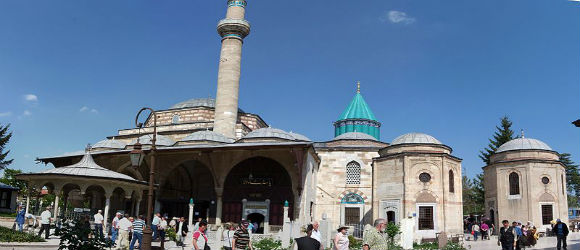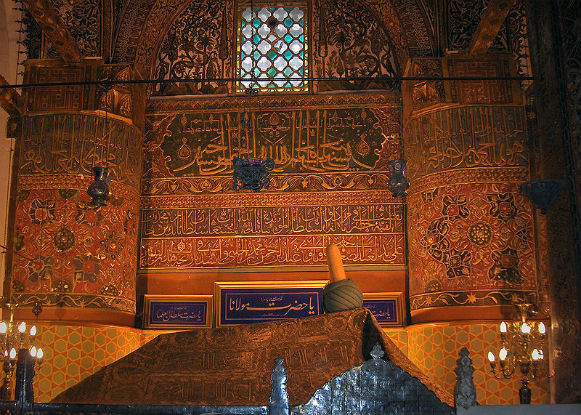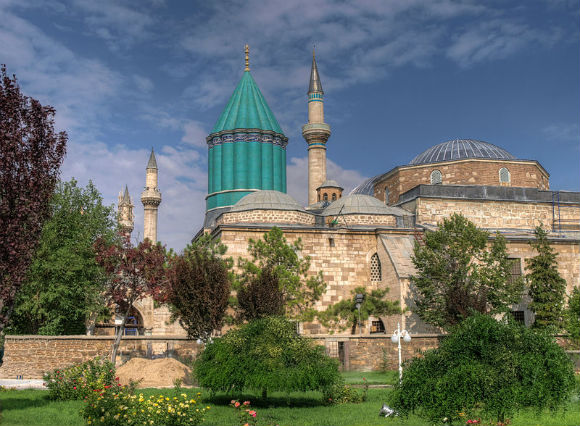The Mevlana Museum also known as the Green Mausoleum or Green Dome, is the original lodge of the Mevlevi Whirling Dervishes, a mystical Sufi Muslim group. It containes the tomb and shrine of the Mevlana, or Rumi, which remains an important place of pilgrimage.
History
Sultan ‘Ala’ al-Din Kayqubad, the Seljuk sultan who had invited Mevlana to Konya, offered his rose garden as a fitting place to bury Baha’ ud-Din Walad (or Bahaeddin Veled), the father of Mevlana, when he died in 1231. When Mevlana himself died on December 17, 1273, he was buried next to his father.
Mevlana’s successor Hüsamettin Çelebi built a mausoleum (Kubbe-i-Hadra) over the grave of his master. The Seljuk construction, under architect Behrettin Tebrizli, was finished in 1274. Gürcü Hatun, the wife of the Seljuk Emir Suleyman Pervane, and Emir Alameddin Kayser funded the construction.
The cylindrical drum of the of the dome originally rested on four pillars. The conical dome is covered with turquoise faience. Several sections were added until 1854. Selim I decorated the interior and performed the woodcarving of the catafalques.
A decree by Ataturk in September 1925 dissolved all Sufi brotherhoods in Turkey. On April 6, 1926, another decree ordered that the Mevlana mausoleum and dervish lodge be turned into a museum. The museum opened on March 2, 1927.
Special permission granted by the Turkish government in 1954 allowed the Mawlawi dervishes of Konya to perform their ritual dances for tourists for two weeks each year. Despite government opposition the order has continued to exist in Turkey as a religious body. The tomb of Rumi, although officially part of a museum, attracts a steady stream of pilgrims.
What to See
The dervish lodge (tekke) includes a semahane, where the ritual sema or whirling ceremony takes place, a sadirvan for ritual ablutions, a library, living and teaching quarters, and the mausoleum housing the tomb of Celaleddin Rumi, founder of the sect and later awarded the honorable title of Mevlana. His epitaph reads: “Do not seek our tombs on this earth – our tombs are in the hearts of the enlightened.”
The mausoleum room is highly ornamented with Islamic script and enameled reliefs, and contains the tombs of several of the more important figures of the dervish order. The main tomb enclosed behind a silver gate crafted in 1597 is that of Mevlana. The tomb of his father, Bahaeddin Veled, is upright and adjacent to his son’s, a position that signifies respect.
The adjoining room, or the semihane, is now a museum of Mevlana memorabilia displaying musical instruments and robes belonging to Mevlana, along with Selçuk and Ottoman objects like gold-engraved Korans from the 13th century. Among the fabulous ancient prayer rugs is the most valuable silk carpet in the world.
Mevlana Museum, Konya,




Knowing very little about Rumi prior to my visit to Konya, I found the Mevlana museum exceptionally helpful in understanding his teachings and the dervishes. The courtyard layout and displays we're well done with just enough amount of detail
I will never forget this place. Every corner is beautiful and gives you a wonderful insight for sufism. The illuminated books were unbelievable.
A beautiful complex of buildings belonging to the Order of Dervishes, Islamic mystics who seek union with God through ecstatic dance.
The disadvantages include the state of toilet for women.
I was not sure what to expect but was pleasantly surprised. The history is well explained and monks little rooms are worth checking out. The gardens were lovely and it was very peaceful sitting and observing.
worth seeing but can be visited quite quickly. Audio guide is very much like a propaganda piece. Lovely gardens.
The Mevlana Museum is a former mosque and location of the tomb of Rumi, a Muslim saint and mystic, who founded the Mevlani movement or what is commonly known as the Whirling Dervishes. This religious shrine provides an excellent opportunity to become acquainted with Rumi's philosophy and teachings. In addition, the interior of the museum is exquisitely well designed and…
If you have the time, you must visit this museum. Very nicely maintained. Photography is not allowed in certain areas of the museum so take care. There is no need for a guided tour since there are detailed information posts at every point written in english.
Lots of people around, some not caring about the expected dress code. Tombs with covers and hats were very interesting, as was Mevlana's large covered tomb. Some people were sniffing a casket through the glass surround, but I have no reason why, perhaps someone could enlighten me?
It is very interesting to learn about this old sect which has been banned in Turkey as a religious group by Atatuk. There are many rooms (old monk cells?) containing displays about Whirling Dervishes' daily and ritual life. Many Muslims still perceive this Mausoleum as a shrine which is very impressive.
This was our second visit and it had been expanded. The displays are well looked after. The beautiful gardens were full of roses.